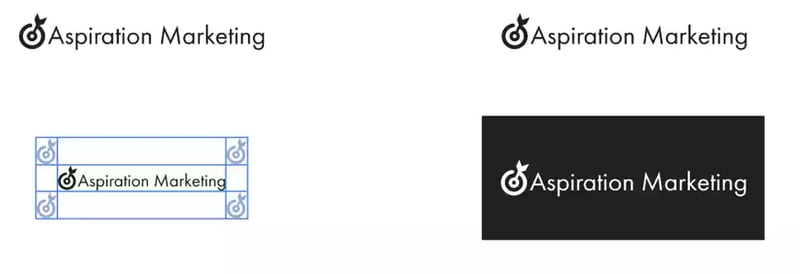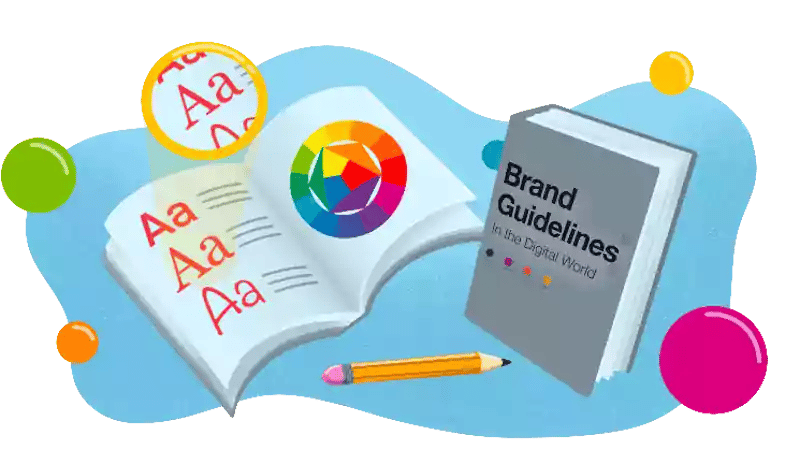¿Qué significa tener directrices de marca?
En un mercado tan competitivo como el actual, establecer una marca fuerte y reconocible es crucial para las empresas que quieren prosperar y destacar. Las directrices de marca son fundamentales para lograr este objetivo, ya que proporcionan un modelo para crear una identidad de marca coherente y cohesiva.
Desde la definición de los componentes clave hasta la descripción del proceso de desarrollo de directrices prácticas de marca, exploraremos cómo estas directrices pueden ayudar a establecer la confianza, mejorar el reconocimiento de la marca y agilizar los procesos de toma de decisiones.
¿Qué son las directrices de marca?
"El branding es el proceso de conectar una buena estrategia con una buena creatividad". Marty Neumeier
Las directrices de marca, o guías o manuales de estilo de marca, sirven como normas e instrucciones que rigen la representación visual y verbal de una marca en diversos canales de marketing. Proporcionan un marco para representar de forma coherente la identidad, los valores y los mensajes de una marca con el fin de crear una experiencia de marca cohesiva y memorable para el público objetivo. Estas directrices garantizan que todos los materiales de marketing, comunicaciones y puntos de contacto reflejen con precisión la personalidad, los valores y la identidad visual de la marca. Además, las directrices de marca son esenciales para las estrategias de marketing de contratación, ya que ayudan a los posibles empleados a crear conciencia de marca.
El 75% de los consumidores afirma que es más probable que hagan negocios con una empresa que tenga una marca sólida, y el 57% dice que es más probable que aumenten su gasto con una marca cuando se sienten conectados. [Sprout Social]
Componentes clave
-
Uso del logotipo: Directrices para el uso, la colocación y el tamaño correctos del logotipo de la marca. Esto garantiza que el logotipo se muestre de forma coherente en diferentes medios y mantenga su integridad visual.
-
Tipografía: Especificaciones para seleccionar y utilizar tipos de letra acordes con el tono y la personalidad de la marca. Incluye directrices sobre tamaños de letra, espaciado y formato para mantener la coherencia en las comunicaciones escritas.
-
Paleta de colores: Definición de la paleta de colores primarios y secundarios de la marca y directrices para su aplicación. Esto incluye especificar los colores primarios de la marca para logotipos, fondos y texto, y los colores complementarios para los elementos visuales.
-
Estilo visual: Instrucciones para elementos visuales como fotografías, ilustraciones, iconos y gráficos. Estas directrices definen el estilo, la composición y el tratamiento preferidos de los activos visuales para garantizar una estética de marca cohesiva.
-
Tono de voz: Orientación sobre la personalidad y la voz de la marca a la hora de comunicarse con el público objetivo. Incluye instrucciones sobre el lenguaje, el estilo de redacción y el tono general del mensaje, ya sea formal, amistoso, profesional o lúdico.
Papel en el establecimiento de la identidad de marca
Las directrices de marca son vitales para establecer y mantener una identidad de marca coherente. Al definir y estandarizar los elementos visuales y verbales, estas directrices garantizan que cada interacción con la marca esté en consonancia con sus valores fundamentales y su personalidad. La coherencia de la marca ayuda a crear reconocimiento, confianza y fidelidad del cliente.
Cuando los elementos visuales de una marca, como logotipos, colores y tipografía, se aplican de forma coherente en los distintos canales de marketing, resulta fácil identificarla. Esta coherencia permite a los clientes asociar señales visuales específicas con la marca, mejorando su memorabilidad y diferenciación en un mercado saturado.
Del mismo modo, un tono de voz y un estilo de mensajería bien definidos ayudan a crear una personalidad de marca coherente. Cuando los clientes se encuentran con el contenido de una marca en un sitio web, en las redes sociales o en campañas publicitarias, deben percibir una voz unificada y reconocible. La coherencia en el tono de voz establece familiaridad y refuerza los valores de la marca, cultivando una conexión más profunda con el público objetivo.
Ventajas de una pauta de marca bien definida
Disponer de una guía de estilo de marca y unas directrices de identidad de marca bien definidas y únicas ofrece numerosas ventajas a las empresas como comercializadoras/vendedoras y como empleadoras:
-
Consistencia y coherencia en todos los canales de marketing: Las directrices de marca garantizan que todos los materiales de marketing, tanto online como offline, se adhieran a los mismos estándares visuales y verbales. Esta coherencia mejora el reconocimiento de la marca y refuerza su identidad, independientemente de dónde la encuentren los clientes.
-
Mayor reconocimiento y recuerdo de la marca: La aplicación coherente de elementos visuales, como logotipos, colores y tipografía, ayuda a los clientes a reconocer y recordar la marca. Cuando las marcas utilizan estos elementos de forma coherente en varios puntos de contacto, se crea una fuerte asociación visual con la marca, haciéndola más memorable.
-
Establecer confianza y credibilidad: La coherencia en la marca infunde confianza a los clientes. Cuando se encuentran con una marca que mantiene una identidad coherente, es señal de profesionalidad, fiabilidad y autenticidad. Esta confianza y credibilidad pueden influir en las decisiones de compra, fomentar la fidelidad del cliente a largo plazo e incluso servir como herramienta de captación.
-
Toma de decisiones racionalizada: Las directrices de marca sirven como punto de referencia para los equipos de marketing y los diseñadores, agilizando el proceso de toma de decisiones a la hora de crear nuevos materiales de marketing. Eliminan las conjeturas y garantizan que todos los materiales se ajusten a la identidad visual y verbal de la marca, ahorrando tiempo y esfuerzo en el proceso creativo.
Siguiendo unas directrices de marca bien definidas, las empresas pueden establecer una presencia de marca fuerte y reconocible, diferenciarse de la competencia y crear conexiones duraderas con su público objetivo.
Cómo elaborar unas directrices de marca
Desarrollar unas directrices de marca eficaces es crucial para crear una identidad de marca coherente y cohesiva. Este proceso implica comprender la identidad y los valores de la marca, definir los elementos visuales y las directrices de diseño, establecer el tono de voz y los mensajes, y esbozar las directrices de la marca para los distintos canales de marketing.
1. Comprender la identidad y los valores de su marca
Antes de crear unas directrices de marca, es esencial tener una idea clara de la identidad y los valores de tu marca. Empiece por definir la misión, la visión y los valores de su marca. ¿Cuál es el propósito de su marca? ¿Qué pretende conseguir? ¿Qué valores y creencias guían las acciones de su marca?
Identifique a su público objetivo y comprenda sus necesidades, preferencias y aspiraciones. Este conocimiento le ayudará a adaptar sus esfuerzos de marca para resonar con su público de manera efectiva.
2. Definir los elementos visuales y las directrices de diseño
Los elementos visuales son cruciales para crear una identidad de marca reconocible y memorable. Definir los elementos visuales y las directrices de diseño que representarán a su marca de forma coherente es esencial a la hora de desarrollar las directrices de marca.
-
Logotipo y tipografía: Especifique el uso correcto, la colocación, el tamaño y los requisitos de espacio libre de su logotipo. Asegúrese de que su logotipo es escalable y adaptable a diversas aplicaciones. Defina los tipos de letra principales y secundarios de su marca y proporcione directrices sobre tamaños de letra, espaciado y formato para mantener la coherencia en todos los materiales de marketing.
-
Paleta de colores e imágenes de marca: Elija una paleta de colores que se ajuste a la personalidad y los valores de su marca. Defina los colores primarios de la marca y los secundarios para fines específicos. Proporcione directrices sobre cómo utilizar los colores en diferentes contextos, garantizando la coherencia en todas las plataformas. Asimismo, establezca directrices para las imágenes de marca, incluidos estilos fotográficos, ilustraciones, iconos y gráficos que reflejen la estética de su marca.
-
Estilo visual coherente: Establezca directrices para mantener un estilo visual coherente en todos los canales de marketing. Esto incluye tratamientos de imagen, principios de maquetación, estilos gráficos y cualquier elemento de diseño único que defina la identidad visual de tu marca.
3. Establecer el tono de voz y los mensajes
El tono de voz y los mensajes de su marca influyen significativamente en la forma en que su público percibe su marca y conecta con ella. Establecer directrices para el tono de voz de su marca garantiza la coherencia cuando se comunica a través de diferentes canales.
-
Definir la voz y la personalidad de la marca: Determina los rasgos de personalidad y las características que representan a tu marca. ¿Es la voz de su marca autoritaria, juguetona, profesional o amistosa? Defina los atributos clave que distinguen a su marca y cree directrices para mantener una voz de marca coherente.
-
Estilo de redacción, lenguaje y tono: Proporcione directrices para el uso del lenguaje, la gramática y el estilo de redacción. Especifique el tono preferido para los distintos tipos de comunicación, ya sea formal, conversacional o técnico. Estas directrices ayudan a garantizar que todo el contenido escrito se alinea con la voz de su marca y transmite el mensaje deseado a su audiencia.
4. Esboce directrices de marca para sus canales de marketing
Las directrices de marca deben extenderse a todos los canales de marketing para mantener una experiencia de marca coherente. Tenga en cuenta los siguientes canales a la hora de definir sus directrices de marca:
-
Sitio web y páginas de destino: Proporcione directrices para el diseño, la disposición y el contenido de su sitio web y páginas de destino. Especifique el uso de elementos visuales, fuentes, colores y directrices para la colocación de logotipos, encabezados, pies de página y menús de navegación para garantizar la coherencia y la facilidad de uso.
-
Perfiles y publicaciones en redes sociales: Establezca directrices para la presencia de su marca en las redes sociales. Define el estilo visual y las directrices de contenido para los perfiles de las redes sociales, las fotos de portada y las fotos de perfil. Proporcione directrices para crear publicaciones atractivas y coherentes en las redes sociales, incluidas las dimensiones de las imágenes, los hashtags y el estilo de redacción.
-
Marketing por correo electrónico y boletines informativos: Especifica directrices para diseñar plantillas de correo electrónico que reflejen la identidad visual de tu marca. Define el diseño, las fuentes, los colores y las imágenes de las campañas de marketing por correo electrónico. Asegúrese de que el tono de voz y los mensajes coinciden con la personalidad de su marca.
-
Materiales y campañas publicitarias: Esboza directrices para crear materiales publicitarios como folletos, carteles, pancartas y anuncios digitales. Asegúrate de que los elementos visuales, la tipografía y los mensajes se ajustan a la identidad de tu marca. Proporcione directrices para mantener la coherencia en diferentes plataformas y formatos publicitarios.
El desarrollo de unas directrices de marca exhaustivas establece una base sólida para una representación coherente de la marca. Estas directrices son una referencia para su equipo y las partes interesadas externas, lo que garantiza la coherencia de su marca en todos los canales de comercialización.
La marca en Aspiration Marketing
Los valores de marca son una parte crucial de nuestra marca en Aspiration Marketing. Son los valores fundamentales en los que cree y defiende nuestra empresa y se incorporan al aspecto de nuestra marca, nuestro sonido y nuestras campañas de marketing.
Para dar un ejemplo (o inspirarte en tus esfuerzos de marca), echa un vistazo entre bastidores a las directrices de marca de Aspiration Marketing.
1. Logotipo
| Uso principal: | Uso positivo y negativo: |

2. Paleta de colores
.webp?width=800&height=333&name=Screen%20Shot%202023-07-17%20at%2012%20(1).webp)
3. Tipografía
Nuestras fuentes principales son Open Sans y Roboto. Los titulares, los subtítulos y el cuerpo del texto se alinean casi siempre a la izquierda.
.webp?width=385&height=400&name=Screen%20Shot%202023-07-17%20at%2012%20(2).webp)
Aunque las directrices de marca van mucho más allá de estos tres componentes, son un buen punto de partida.
El poder de las directrices de marca: El camino hacia el éxito de su marca
Directrices de marca: el secreto para crear una marca tan coherente como su café matutino. Estas directrices no son sólo documentos elegantes; son el proyecto que garantiza que la identidad de su marca se mantiene en todos los canales de marketing. Comprendiendo los valores de su marca, definiendo los elementos visuales y las directrices de diseño y estableciendo un tono de voz suave como la mantequilla, puede crear una experiencia de marca que deje una impresión duradera.
Una identidad de marca bien ejecutada no es ninguna broma. Es la clave para crear reconocimiento, confianza y lealtad entre su público objetivo. Y no olvidemos que estas directrices también facilitan la vida a su equipo de marketing, ahorrándoles interminables debates sobre fuentes y colores. Aproveche el poder de las directrices de marca y vea cómo su marca alcanza nuevas cotas.
Este contenido también está disponible traducido en:
- Alemán: Was bedeutet es, Branding-Leitlinien zu haben?
- Inglés: What Does it Mean to Have Branding Guidelines?
- Francés: Stratégie de marque : Pourquoi des lignes directrices ?
- Italiano: Cosa significa avere linee guida per il branding?
- Rumano: Ce înseamnă să ai linii directoare pentru branding?
- Chino: 制定品牌准则意味着什么?









Deja un comentario